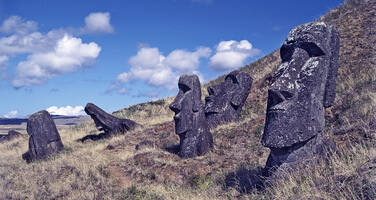Rapa Nui National Park
Factors affecting the property in 1998*
- High impact research / monitoring activities
- Marine transport infrastructure
International Assistance: requests for the property until 1998
Total amount approved : 9,000 USD
| 1992 | Consultancies and other costs for the preparation of ... (Approved) | 7,500 USD |
| 1990 | Travel and perdiem costs of 2 Chilean participants in ... (Approved) | 1,500 USD |
Missions to the property until 1998**
Conservation issues presented to the World Heritage Committee in 1998
Early 1998, the Secretariat received information about the possible construction of a new harbour within the World Heritage site, the extraction of stone and problems in the management of the Park. In response, the Chilean authorities informed that the harbour project was indeed considered some years ago but that this project at present was not being pursued; and that the extraction of stone is strictly controlled by the Council of National Monuments in accordance with what is foreseen in the Management Programme for the Natural Heritage and the Master Plan for the Nui National Park. A close collaboration has been established between the Council for National Monuments and the National Forestry Agency (CONAF) and consultations with the local authorities are taking place. No new authorisations have been given for archaeological excavations, awaiting a specific ordinance for excavations and research.
As to the management of the Park, the authorities informed that a Management Plan for The Nui National Park was adopted in February 1998, copy of which was made available to the Secretariat and ICOMOS.
A comprehensive programme for the preservation of Rapa Nui has been prepared by the National Conservation Centre, the University of Chile and the National Forestry Agency (CONAF) and submitted for consideration under the Japanese Funds-in-Trust. The programme would include items such as: the preservation of stone, cultural anthropology, the environment and equipment.
The Bureau thanked the Chilean authorities for the information provided on the management of the Park and the adoption of the management plan. It requested the Chilean authorities to keep the Committee informed of future planning, infrastructural works and excavations that might be planned for the Park.
Summary of the interventions
Decisions adopted by the Committee in 1998
22 COM VII.43
Reports on the State of Conservation of Cultural Properties Noted by the Committee
VII.43 The Committee noted the decisions of the twenty-second extraordinary session of the Bureau as reflected in the Report of the Bureau session (Working Document WHC-98/CONF.203/5) and included in Annex IV of this report on the following properties:
Rapa Nui National Park (Chile)
The Mountain Resort and Its Outlying Temples in Chengde (China)
The Potala Palace, Lhasa (China)
Temple and Cemetery of Confucius and the Kong Family Mansion in Qufu (China)
Ancient Building Complex in the Wudang Mountains (China)
City of Quito (Ecuador)
Memphis and its Necropolis - the Pyramid Fields from Giza to Dahshur (Egypt)
Ancient Thebes with its Necropolis (Egypt)
Islamic Cairo (Egypt)
Historic Centre (Old Town) of Tallinn (Estonia)
Collegiate Church, Castle and Old Town in Quedlinburg (Germany)
Historic Centre of Florence (Italy)
Quseir Amra (Jordan)
Luang Prabang (Laos)
Baalbek (Lebanon)
Tyre (Lebanon)
Vilnius Historic Centre (Lithuania)
Old Towns of Djenné (Mali)
City of Cusco (Peru)
Archaeological site of Chavin (Peru)
Historic Centre of Lima (Peru)
The Baroque Churches of the Philippines (The Philippines)
Historic Centre of Porto (Portugal)
Island of Gorée (Senegal)
Sacred City of Anuradhapura (Sri Lanka)
Ancient City of Polonnaruva (Sri Lanka)
Ancient City of Sigiriya (Sri Lanka)
Site of Palmyra (Syrian Arab Republic)
Historic Areas of Istanbul (Turkey)
Kiev: Saint Sophia Cathedral and Related Monastic Buildings (Ukraine)
Complex of Hué Monuments (Vietnam)
Old City of Sana'a (Yemen)
No draft Decision
* :
The threats indicated are listed in alphabetical order; their order does not constitute a classification according to the importance of their impact on the property.
Furthermore, they are presented irrespective of the type of threat faced by the property, i.e. with specific and proven imminent danger (“ascertained danger”) or with threats which could have deleterious effects on the property’s Outstanding Universal Value (“potential danger”).
** : All mission reports are not always available electronically.


